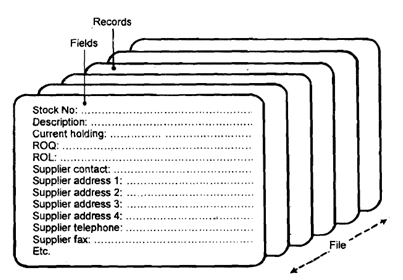Database Management Software: For storage of large amounts of varied data, and rapid retrieval and interpretations of data, the database is the ideal tool. It is most useful for stock control.
Generally it tells a computer to behave just like a card index system. In computing terms the entire card index is called a file, each card is called a record, and each line of information on the card is called a file. Good database software will allow you to store information in exactly the same way as your index card.
A relational database is a type of computer program that allows you to store different information on a similar format for many different items. It also enables you to retrieve that information rapidly in a variety of ways. It can be used for applications like maintaining personnel records or student records, preparation of mailing lists and many other operations of a similar nature.
Figure is an example of how a stock control data file might look for a database program. The concept is similar to a conventional card index system. The master file (your stock control file) contains many 'records'. Each 'record' relates in this case to a different stock item uniquely identified by its stock number. For each record there are several 'fields' or sections of information. In this case, the field descriptions are shown - stock number, description, etc.
The advantage that the computer has over a card index system is space. It can store thousands of records on many master files. That is the equivalent of many large card index systems. Also in a matter of a few seconds, the program could, in the case of the example in Fig. 9.3, list, say, all records for which a re-order was due.
It would do this by comparing the data in the 'requirement' field with the data in the 'current holding' field and list all stock items where the 'current holding' is less than 'requirement'. This program would print the address labels of the supplier for you.

Figure: Pictorial representation of a Data File